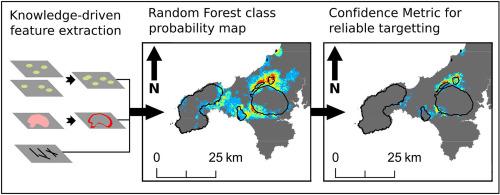Geoscience Frontiers ( IF 8.9 ) Pub Date : 2020-06-20 , DOI: 10.1016/j.gsf.2020.05.016 Christopher M. Yeomans , Robin K. Shail , Stephen Grebby , Vesa Nykänen , Maarit Middleton , Paul A.J. Lusty

|
Novel mineral prospectivity modelling presented here applies knowledge-driven feature extraction to a data-driven machine learning approach for tungsten mineralisation. The method emphasises the importance of appropriate model evaluation and develops a new Confidence Metric to generate spatially refined and robust exploration targets. The data-driven Random Forest™ algorithm is employed to model tungsten mineralisation in SW England using a range of geological, geochemical and geophysical evidence layers which include a depth to granite evidence layer. Two models are presented, one using standardised input variables and a second that implements fuzzy set theory as part of an augmented feature extraction step. The use of fuzzy data transformations mean feature extraction can incorporate some user-knowledge about the mineralisation into the model. The typically subjective approach is guided using the Receiver Operating Characteristics (ROC) curve tool where transformed data are compared to known training samples. The modelling is conducted using 34 known true positive samples with 10 sets of randomly generated true negative samples to test the random effect on the model. The two models have similar accuracy but show different spatial distributions when identifying highly prospective targets. Areal analysis shows that the fuzzy-transformed model is a better discriminator and highlights three areas of high prospectivity that were not previously known. The Confidence Metric, derived from model variance, is employed to further evaluate the models. The new metric is useful for refining exploration targets and highlighting the most robust areas for follow-up investigation. The fuzzy-transformed model is shown to contain larger areas of high model confidence compared to the model using standardised variables. Finally, legacy mining data, from drilling reports and mine descriptions, is used to further validate the fuzzy-transformed model and gauge the depth of potential deposits. Descriptions of mineralisation corroborate that the targets generated in these models could be undercover at depths of less than 300 m. In summary, the modelling workflow presented herein provides a novel integration of knowledge-driven feature extraction with data-driven machine learning modelling, while the newly derived Confidence Metric generates reliable mineral exploration targets.
中文翻译:

一种基于知识驱动特征提取和模型置信度的钨矿远景建模的机器学习方法
本文介绍的新型矿物前景模型将知识驱动的特征提取应用于数据驱动的机器学习方法,以进行钨矿化。该方法强调了进行适当模型评估的重要性,并开发了一种新的置信度指标来生成空间精炼且稳健的勘探目标。数据驱动的Random Forest™算法用于使用一系列地质,地球化学和地球物理证据层(其中包括花岗岩证据层的深度)对西南英格兰的钨矿化进行建模。提出了两个模型,一个模型使用标准化的输入变量,第二个模型将模糊集理论用作增强特征提取步骤的一部分。模糊数据转换的使用意味着特征提取可以将有关矿化的一些用户知识整合到模型中。使用接收器工作特征(ROC)曲线工具指导通常的主观方法,其中将转换后的数据与已知训练样本进行比较。使用34个已知的真实阳性样本和10组随机生成的真实阴性样本进行建模,以测试对模型的随机影响。两种模型的准确性相似,但在识别高度预期目标时显示出不同的空间分布。地域分析表明,模糊变换的模型是更好的判别器,并突出了以前未知的三个高前景区域。从模型方差得出的置信度度量标准用于进一步评估模型。新指标可用于完善勘探目标并突出最有力的后续调查领域。与使用标准变量的模型相比,模糊变换的模型显示出包含更大的模型可信度区域。最后,来自钻探报告和矿山描述的遗留采矿数据被用于进一步验证模糊转换的模型并评估潜在矿床的深度。矿化描述证实了这些模型中产生的目标可能在小于300 m的深度被掩盖。总而言之,本文介绍的建模工作流提供了知识驱动的特征提取与数据驱动的机器学习建模的新型集成,而新派生的Confidence Metric生成了可靠的矿产勘探目标。钻探报告和矿山描述中的数据,可用于进一步验证模糊转换的模型并评估潜在矿床的深度。矿化描述证实了这些模型中产生的目标可能在小于300 m的深度被掩盖。总而言之,本文介绍的建模工作流提供了知识驱动的特征提取与数据驱动的机器学习建模的新型集成,而新派生的Confidence Metric生成了可靠的矿产勘探目标。钻探报告和矿山描述中的数据,可用于进一步验证模糊转换的模型并评估潜在矿床的深度。矿化描述证实了这些模型中产生的目标可能在小于300 m的深度被掩盖。总而言之,本文介绍的建模工作流提供了知识驱动的特征提取与数据驱动的机器学习建模的新型集成,而新派生的Confidence Metric生成了可靠的矿产勘探目标。


























 京公网安备 11010802027423号
京公网安备 11010802027423号